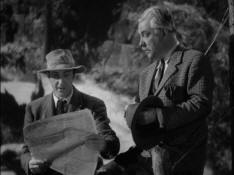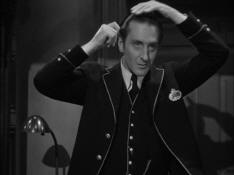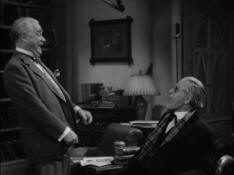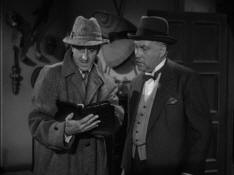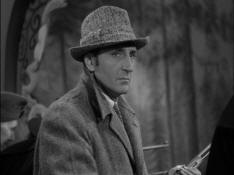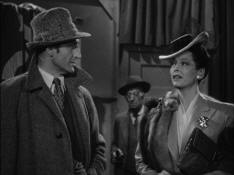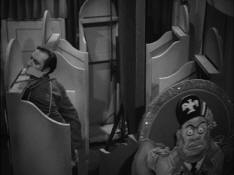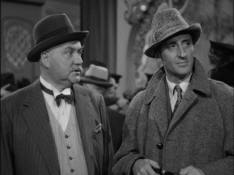The
Spider Woman
|
 Holmes (in disguise) reels from Watson's punch |
|
"The current installment of the master-sleuth serial is above the average in plausibility, suspense and interest and has been really quite well presented. ... Rathbone has grown practically letter-perfect in his characterization" G. E. Blackford, New York Journal-American, January 15, 1944
"All the ingredients needed to please the devotees of the great Baker St. sleuth are here in bountiful measure, and the fundamentals make this the best in the new series of screen adventures of the inimitable pair. ... Basil Rathbone has built up a perfect characterization, and Nigel Bruce has carried Dr. Watson far beyond the delightfully stodgy gentleman conceived by Conan Doyle." The Capital Times (Madison, Wisconsin), January 27, 1944
|
THE SPIDER WOMAN An especially ingenious plot places The Spider Woman among the best of the Sherlock Holmes series. Peculiar circumstances in connection with a number of so-called 'pyjama suicides' in London cause the master detective to suspect murder. He is right, of course, and he traps the killer after assuming various disguises and risking a horrible death Even though everyone knows that Sherlock Holmes must always survive to solve new mysteries, the suspense is very real, and the man-killing spider which plays an important part will give many people the creeps. The cast, as usual, is superior. Adolescents, 12 to 16: Good of its kind Children, 8 to 12: Probably frightening Motion Picture Reviews, JanuaryFebruary 1944 |
"Spider Woman is especially good for followers of the adventures of Arthur Conan Doyle's Sherlock Holmes and Dr. Watson, who are again admirably portrayed by Basil Rathbone and Nigel Bruce. It will send chills down the spines of the most hardened mystery fans; it will play havoc with the nerves of those unaccustomed to Holmes' methods and "elementary" deductions, but it will doubtless be a pleasant form of nervous prostration, for this is one of the best of the Holmes' adventures." Helen McNamara, Motion Picture Daily, January 6, 1944
"Basil Rathbone, as Sherlock Holmes, and Nigel Bruce, as Dr. Watson, give their usual substantial performances in this film, one of a series of mysteries based on novels by Sir Arthur Conan Doyle." Variety, January 12, 1944
"Basil Rathbone plays the versatile detective with his usual serene elegance, while Nigel Bruce and Dennis Hoey are his old, reliable, thick-skulled mates." Bosley Crowther, New York Times, January 15, 1944
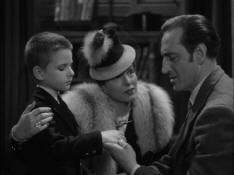 Adrea Spedding and her "nephew" visit Holmes. |
|
"Basil Rathbone is a lean and perfect Holmes and Nigel Bruce a blundering lambie-pie of a Watson. Gale Sondergaard stalks around too, but we liked the spider better." Photoplay, April 1944
"This latest of the Sherlock Homes murder mystery melodramas is moderately entertaining program fare. Like the other pictures in the series, this, too has a far-fetched plot, and the unraveling of the mystery depends not on logic, but on the master detective's amazing powers of deduction. Since it is obvious from the start who the criminals are, the interest lies, not in the discovery of their identities, but in the manner in which they are apprehended." Harrison's Reports, December 18, 1943
"The film sees both Rathbone and Bruce at their most typical and endearing, and is justifiably regarded as one of the gems in this set of adaptations." Graeme Clark, The Spinning Image
|
Sherlock Holmes and Spider Woman AUDIENCE SLANT: (Family) An excellent murder yarn with plenty of surprises and suspense. BOX-OFFICE SLANT: Good supporting picture which lends itself to special exploitation. Equal to tops in series. Plot: Sherlock Holmes disappears and is purported to have drowned while on a fishing trip Dr. Watson is disposing of his friends possessions when Holmes returns under a disguise explaining that his widely publicized death was deliberately planned to expose a baffling pajama murder ring. Homes, through a series of attempts on his life, eventually tracks down the Spider Woman who is responsible for the series of crimes. Comment: This is a skillfully concocted yarn which places the life of fiction's most famous detective personality constantly in jeopardy. Holmes' hairbreadth escapes are carefully spaced to maintain a goodly pace of suspense. No attempt is made to conceal the identity of the murderer as the story deals principally with Holmes endeavors to procure ample evidence to bring the criminals to justice. The final sequence places his life unwittingly in the hands of Dr. Watson with the action taking place in an up-to-date shooting gallery using dummies of Hitler, Mussolini and Hirohito. Holmes saves himself and captures the Spider Woman. Exploitation of this film can take many forms with the "Pajama Murder" theme, playing up the shooting gallery sequence, Holmes' "death" or the "Spider Woman" angle. Showman's Trade Review, January 8, 1944 |
"Basil Rathbone as Sherlock Holmes, and Nigel Bruce as Dr. Watson push their expert portrayals to new heights in this number, best of the series." Motion Picture Herald, January 15, 1944
"Neat direction, atmosphere and adequate acting see this Universal picture throughthe story, if analyzed, hasn't a leg to stand on. ... Rathbone is as usual. Nigel Bruce, the apparently slow-witted Dr. Watson of the series, has better comedy lines in this Holmes chapter and Gale Sondergaard makes a delightful meanie." Wanda Hale, The New York Daily News, January 15, 1944
"Gale Sondergaard was cast as the sinister Adrea Spedding, and her scenes with Rathbone, in which the two talented performers play a 'cat and mouse' game of innuendos, were the high points of the film." Michael B. Druxman, Basil Rathbone: His Life and His Films, 1975
Return to Page One of The Spider Woman.
Go to Page Three for pictures of Posters, Lobby Cards, and Studio Promo Photos







